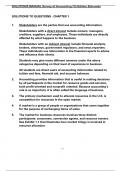SOLUTIONS MANUAL Survey of Accounting 7th Edition Edmonds
SOLUTIONS TO QUESTIONS - CHAPTER 1
1. Stakeholders are the parties that use accounting information.
Stakeholders with a direct interest include owners, managers,
creditors, suppliers, and employees. These individuals are directly
affected by what happens to the business.
Stakeholders with an indirect interest include financial analysts,
brokers, attorneys, government regulators, and news reporters.
These individuals use information in the financial reports to advise
and influence their clients.
Students may give many different answers under the above
categories depending on their level of experience in business.
All students are direct users of accounting information related to
tuition and fees, financial aid, and account balances.
2. Accounting provides information that is useful in making decisions
by all participants in the market for resource goods and services,
both profit-oriented and nonprofit oriented. Because accounting’s
role is so important, it is often called the language of business.
3. The primary mechanism used to allocate resources in the U.S. is
competition for resources in the open market.
4. A market is a group of people or organizations that come together
for the purpose of exchanging items of value.
5. The market for business resources involves three distinct
participants: consumers, conversion agents, and resource owners.
See Exhibit 1-1 that illustrates how market trilogy is involved in
resource allocation.
1-1
,6. Financial Resource: money
Physical Resource: natural resources (i.e. land, forests, mine ore,
petroleum, etc.), buildings, machinery and equipment, furniture and
fixtures
Labor Resource: includes both intellectual and physical labor; i.e.
employees
7. Investors expect a distribution of the business’s profits as a return
on their financial investment (capital allocation).
Creditors lend financial resources to businesses and receive interest
as a return or profit on the loan.
8. Financial accounting provides information that is useful to external
resource providers.
Managerial accounting provides information that is useful to
managers in operating an organization (i.e., internal users).
9. Not-for-profit or nonprofit entities provide goods or services to
consumers for humanitarian or special reasons rather than to earn a
profit for owners. For example, certain not-for-profit entities allocate
resources to provide for research of diseases or
social/environmental welfare; others allocate resources to promote
the arts and provide education.
10. The U.S. rules of accounting information measurement are called
generally accepted accounting principles (GAAP).
1-2
,11. Careers in public accounting consist of providing services to the
general public from a public accounting firm. These services include
auditing, tax, and consulting services. Careers in private accounting
usually consist of working for a specific company (which would be a
client of the public accounting firm) providing a wide variety of
services to the company including recording transactions, preparing
financial statements, internal auditing, and others.
12. The three elements of the accounting equation are:
1. Assets
2. Liabilities
3. Stockholders’ Equity
Accounts are specific items or subclassifications of the elements.
Examples of accounts include cash, land, and accounts payable.
13. Assets, the economic resources of a business, are used to produce
earnings.
14. The assets of a business belong to that business entity and there
may be claims on the assets. Claims on the assets belong to
resource providers.
15. Creditors are individuals and/or institutions that have provided
goods or services to the business which are not yet paid for, or
loaned money to the business. These parties have first claim to the
assets of the business, and the owners have a residual interest in the
assets.
16. The term “liabilities” is used to describe creditors' claims on the
assets of a business.
1-3
, 17. The accounting equation is:
ASSETS − LIABILITIES = STOCKHOLDERS’ EQUITY
or
ASSETS = LIABILITIES + STOCKHOLDERS’ EQUITY
Assets are the economic resources used by a business for the
production of revenue. Liabilities are obligations of a business to
relinquish assets, provide services, or accept other obligations.
Stockholders’ Equity, also called “residual interest” or “net assets,”
is the portion of the assets remaining after the creditors' claims have
been satisfied (i.e., Assets − Liabilities).
18. The owners ultimately bear the risk and collect the rewards
associated with operating a business.
19. A double-entry bookkeeping system is one in which every
transaction affects at least two accounts. A transaction can affect
both assets and claims (liabilities and equity) or only assets or only
claims. In order to “balance” the accounting equation, every
transaction requires a “double entry.”
20. Capital is acquired from owners by issuing stock to them. When
stock is issued, the assets of the business increase and the
stockholders’ equity increases.
21. Assets that are acquired by issuing common stock are the result of
investments by owners. Assets that are acquired by using retained
earnings are assets the business acquires through its earnings
activities.
22. Revenue increases the asset side of the accounting equation and
also increases the retained earnings account in the stockholders’
equity section of the equation.
23. The three primary sources of assets are (1) investments by owners
(issue of stock), (2) borrowing from creditors, and (3) earnings
activities.
24. Retained earnings are a result of a business retaining its earned
assets, rather than distributing those earnings to its owners.
1-4




